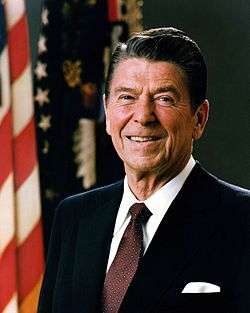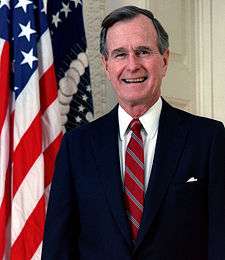United States presidential election, 1984
| | |||||||||||||||||||||||||||||||||||||||||||
| |||||||||||||||||||||||||||||||||||||||||||
| |||||||||||||||||||||||||||||||||||||||||||
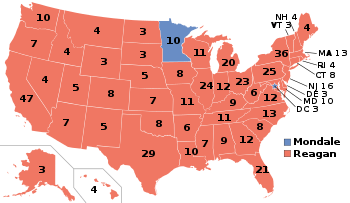
 | |||||||||||||||||||||||||||||||||||||||||||
| Presidential election results map. Red denotes states won by Reagan/Bush, blue denotes the state won by Mondale/Ferraro. | |||||||||||||||||||||||||||||||||||||||||||
| |||||||||||||||||||||||||||||||||||||||||||
The United States presidential election of 1984 was the 50th quadrennial presidential election. It was held on Tuesday, November 6, 1984. The contest was between the incumbent President Ronald Reagan, the Republican candidate, and former Vice President Walter Mondale, the Democratic candidate.
Reagan carried 49 of the 50 states, becoming one of only two candidates to do so (the other was Richard Nixon in the 1972 presidential election). Reagan touted a strong economic recovery from 1970s stagflation and the 1981–82 recession, as well as the widespread perception that his presidency had overseen a revival of national confidence and prestige.[2]
Although Mondale received 40.6% of the popular vote, electoral votes are awarded on a winner-take-all basis in each state, resulting in a lopsided electoral vote count. Mondale's only electoral votes came from the District of Columbia, which has never given its electoral votes to a Republican candidate, and his home state of Minnesota, which he won by a mere 3,761 votes.
Reagan's 525 electoral votes (out of 538) is the highest total received by a presidential candidate. His showing ranks fifth by percentage of electoral votes received (97.58%) out of total available electoral votes, just shy of the 523 out of 531 (98.49%) received by Franklin D. Roosevelt in 1936. Mondale's 13 electoral votes is also the second-fewest received by a second-place candidate, second only to Alf Landon's 8 in 1936. In the national popular vote, Reagan received 58.8% to Mondale's 40.6% and the percentage of his margin of victory ranks 7th of all presidential elections. No candidate since then has managed to equal or surpass Reagan's 1984 electoral result. Also, no post-1984 Republican candidate has managed to match Reagan's electoral performance in the Northeastern United States and in the West Coast states. At 73, Reagan was the oldest president and oldest presidential candidate to win a presidential election.
Nominations
Republican Party candidates
- Ronald Reagan, President of the United States
- Harold Stassen, former governor of Minnesota
- Ben Fernandez, former Special Ambassador to Paraguay, from California
Candidates gallery
-

Former Governor
Harold Stassen
of Minnesota
Primaries
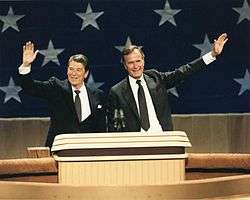
Ronald Reagan—the incumbent president—was the assured nominee for the Republican Party, with only token opposition. The popular vote from the Republican primaries was as follows:[3]
- Ronald Reagan (inc.): 6,484,987 (98.78%)
- Unpledged delegates: 55,458 (0.85%)
- Harold Stassen: 12,749 (0.19%)
- Benjamin Fernandez: 202 (0.00%)
Reagan was renominated by a vote of 2,233 delegates (two delegates abstained). For the only time in American history, the vice presidential roll call was taken concurrently with the presidential roll call. Vice President George H. W. Bush was overwhelmingly renominated. This was the last time in the 20th century that the vice presidential candidate of either major party was nominated by roll call vote.
| Presidential Ballot | Vice Presidential Ballot | ||
|---|---|---|---|
| Ronald Reagan | 2,233 | George H. W. Bush | 2,231 |
| Abstaining | 2 | Abstaining | 2 |
| Jack Kemp | 1 | ||
| Jeane Kirkpatrick | 1 |
Democratic Party candidates
- Walter Mondale, former Vice President and former U.S. senator from Minnesota
- Gary Hart, U.S. senator from Colorado
- Jesse Jackson, reverend and civil rights activist from Illinois
- John Glenn, U.S. senator from Ohio
- George McGovern, former U.S. senator and 1972 Democratic nominee from South Dakota [4]
- Reubin Askew, former Governor of Florida
- Alan Cranston, U.S. senator from California
- Ernest Hollings, U.S. senator from South Carolina
Candidates gallery
-
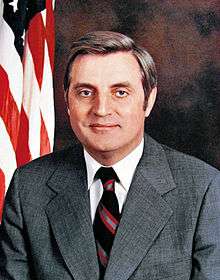
Former Vice President
Walter Mondale,
from Minnesota -

Reverend
Jesse Jackson
from Illinois -
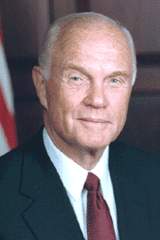
Senator
John Glenn
from Ohio
(Withdrew – March 17, 1984) -

Former Senator
George McGovern
from South Dakota
(Withdrew – March 13, 1984)
(Endorsed Mondale – Jun. 13) -
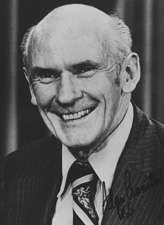
Senator
Alan Cranston
from California
(Withdrew – February 29, 1984) -

Senator
Ernest Hollings
from South Carolina
(Withdrew – March 1, 1984)
(Endorsed Hart – Mar. 9) -
Former Governor
Reubin Askew
of Florida
(Withdrew – March 1, 1984)
Primaries
Only three Democratic candidates won any state primaries: Mondale, Hart, and Jackson. Initially, Massachusetts Senator Ted Kennedy, after a failed bid to win the 1980 Democratic nomination for president, was considered the de facto front-runner of the 1984 primary. But, after Kennedy ultimately declined to run, former Vice-President Mondale was then viewed as the favorite to win the Democratic nomination. Mondale had the largest number of party leaders supporting him, and he had raised more money than any other candidate. However, both Jackson and Hart emerged as surprising, and troublesome, opponents.
South Carolina Senator Ernest Hollings's wit and experience, as well as his call for a budget freeze, won him some positive attention, but his relatively conservative record alienated liberal Democrats, and he was never really noticed in a field dominated by Walter Mondale, John Glenn, and Gary Hart. Hollings dropped out two days after losing badly in New Hampshire, and endorsed Hart a week later. His disdain for his competitors was at times showcased in his comments. He notably referred to Mondale as a "lapdog," and to former astronaut Glenn as "Sky King" who was "confused in his capsule."[5]
California Senator Alan Cranston hoped to galvanize supporters of the nuclear freeze movement that had called on the United States to halt the deployment of existing nuclear weapons and the development of new ones. Glenn and Askew hoped to capture the support of moderate and conservative Democrats. None of them possessed the fundraising ability of Mondale nor the grassroots support of Hart and Jackson, and none won any contests.
Jackson was the second African-American (after Shirley Chisholm) to mount a nationwide campaign for the presidency, and he was the first African-American candidate to be a serious contender. He got 3.5 million votes during the primaries, third behind Hart and Mondale. He won the primaries in Virginia, South Carolina, and Louisiana, and split Mississippi, where there were two separate contests for Democratic delegates. Through the primaries, Jackson helped confirm the black electorate's importance to the Democratic Party in the South at the time. During the campaign, however, Jackson made an off-the-cuff reference to Jews as "Hymies" and New York City as "Hymietown," for which he later apologized. Nonetheless, the remark was widely publicized, and derailed his campaign for the nomination.[6] Jackson ended up winning 21% of the national primary vote but received only 8% of the delegates to the national convention, and he initially charged that his campaign was hurt by the same party rules that allowed Mondale to win. He also poured scorn on Mondale, saying that Hubert Humphrey was the "last significant politician out of the St. Paul-Minneapolis" area.[7]
Hart, from Colorado, was a more serious threat to Mondale, and after winning several early primaries it looked as if he might take the nomination away from Mondale. Hart finished a surprising second in the Iowa caucuses, with 16.5% of the vote. This established him as the main rival to Mondale, effectively eliminating John Glenn, Ernest Hollings and Alan Cranston as alternatives. Hart criticized Mondale as an "old-fashioned" New Deal Democrat who symbolized "failed policies" of the past. Hart positioned himself (just as Bill Clinton would eight years later) as a younger, fresher, and more moderate Democrat who could appeal to younger voters. He emerged as a formidable candidate, winning the key New Hampshire, Ohio, and California primaries as well as several others, especially in the West. However, Hart could not overcome Mondale's financial and organizational advantages, especially among labor union leaders in the Midwest and industrial Northeast.
Hart was also badly hurt in a televised debate with Mondale during the primaries, when the former vice president used a popular television commercial slogan to ridicule Hart's vague "New Ideas" platform. Turning to Hart on camera, Mondale told Hart that whenever he heard Hart talk about his "New Ideas," he was reminded of the Wendy's fast-food slogan "Where's the beef?" The remark drew loud laughter and applause from the viewing audience and caught Hart off-guard. Hart never fully recovered from Mondale's charge that his "New Ideas" were shallow and lacking in specifics.
At a roundtable debate between the three remaining Democratic candidates moderated by Phil Donahue, Mondale and Hart got in such a heated argument over the issue of U.S. policy in Central America that Jackson had to tap his water glass on the table to help get them to stop.
Mondale gradually pulled away from Hart in the delegate count, but, as Time reported in late May, "Mondale ... has a wide lead in total delegates (1,564 to 941) ... because of his victories in the big industrial states, his support from the Democratic Establishment and the arcane provisions of delegate-selection rules that his vanguard helped draft two years ago."[8] After the final primary in California, on June 5, which Hart won, Mondale was about 40 delegates short of the total he needed for the nomination.[9] However, at the Democratic National Convention in San Francisco on July 16, Mondale received the overwhelming support of the unelected superdelegates from the party establishment to win the nomination.
This race for the Democratic Party presidential nomination was the closest in two generations, and it was the last occasion that a major party's race for the presidential nomination went all the way to its convention until 2016.
Endorsements
Note: These are only those endorsements which occurred during or before the Primary Race.
|
List of Walter Mondale endorsements |
|---|
|
Mondale had received endorsements from:
|
|
List of Gary Hart endorsements |
|---|
|
Hart had received endorsements from:
|
|
List of Jesse Jackson endorsements |
|---|
|
Jackson had received endorsements from:
|
|
List of John Glenn endorsements |
|---|
|
Glenn had received endorsements from:
|
|
List of Alan Cranston endorsements |
|---|
|
Cranston had received endorsements from:
|
|
List of Reubin Askew endorsements |
|---|
|
Askew had received endorsements from:
|
Convention
This was the convention's nomination tally:
| Presidential Ballot | Vice Presidential Ballot | ||
|---|---|---|---|
| Walter F. Mondale | 2,191 | Geraldine A. Ferraro | 3,920 |
| Gary W. Hart | 1,200.5 | Shirley Chisholm | 3 |
| Jesse L. Jackson | 465.5 | ||
| Thomas F. Eagleton | 18 | ||
| George S. McGovern | 4 | ||
| John H. Glenn | 2 | ||
| Joe Biden | 1 | ||
| Lane Kirkland | 1 |
When he made his acceptance speech at the Democratic Convention, Mondale said: "Let's tell the truth. Mr. Reagan will raise taxes, and so will I. He won't tell you. I just did."[43] Although Mondale intended to expose Reagan as hypocritical and position himself as the honest candidate, the choice of taxes as a discussion point likely damaged his electoral chances.
Vice-Presidential nominee
Mondale chose U.S. Rep. Geraldine A. Ferraro from New York as his running mate, making her the first woman nominated for that position by a major party, and the second Italian American on a major party ticket. Mondale wanted to establish a precedent with his vice presidential candidate, although Tonie Nathan of the Libertarian Party was already the first woman to receive an electoral vote in the 1972 election. Another reason for the nominee to "go for broke" instead of balancing the ticket was Reagan's lead in the polls; Mondale hoped to appeal to women, by 1980 the majority of voters, by choosing Ferraro. In a "much criticized parade of possible Veep candidates" to his home in Minnesota, Mondale considered San Francisco Mayor Dianne Feinstein and Kentucky Governor Martha Layne Collins, also female; Los Angeles Mayor Tom Bradley, an African American; and San Antonio Mayor Henry Cisneros, a Hispanic, as other finalists for the nomination, and chose Ferraro because he hoped that she would attract ethnic voters with her personal background.[7][44] Unsuccessful nomination candidate Jackson derided Mondale's vice-presidential screening process as a "P.R. parade of personalities," but praised Mondale for his choice, having himself pledged to name a woman to the ticket in the event he was nominated.
Mondale had wanted to choose New York Governor Mario Cuomo as his running mate, but Cuomo declined and recommended Ferraro,[45] his protégée.[46] The nominee would likely have named Massachusetts Governor Michael Dukakis as his running mate had he made a "safe" choice".[44] Others preferred Senator Lloyd Bentsen because he would appeal to more conservative Southern voters. Nomination rival Gary Hart stated before Ferraro's selection that he would accept an invitation to run with Mondale;[44] Hart's supporters claimed he would do better than Mondale against President Reagan, an argument undercut by a June 1984 Gallup poll that showed both men nine points behind the president.
Other parties
National Unity Party nomination
-

Former Representative
John B. Anderson
from Illinois
(Declined to Run – April 26, 1984)
(Endorsed Mondale – August 27)
The National Unity Party was an outgrowth of John Anderson's presidential campaign from the 1980 presidential election. Anderson hoped that the party would be able to challenge the "two old parties", which he viewed as being tied to various special interest groups and incapable of responsible fiscal reform. The intention was to organize the new party in California, Oregon, Washington, Illinois, the New England states, and others where his previous candidacy had proven to have experienced the most success. The party was also eligible for $5.8 million in Federal election funds, but its qualification depended on it being on the ballot in at least ten states; however, it remained unclear if National Unity could actually obtain the funds, or if it needed to be Anderson himself.
Anderson initially was against running, hoping that another notable politico would take the party into the 1984 election, and feared that his own candidacy might result in the party being labeled a "personality cult". However no candidate came forward resulting in Anderson becoming the nominee in waiting. While Anderson had managed to find equal support from the Republicans and Democrats in the 1980 election, the grand majority of the former had since switched back, resulting in the new party being supported principally by those who normally would vote Democratic, which it was feared might make him a spoiler candidate. In light of this, in addition to difficulties in getting on the ballot in his targeted states (Utah and Kentucky were the only two, neither among those he intended to prominently campaign in), Anderson ultimately declined to run. Later he would endorse the Democratic nominee, Walter Mondale.
Anderson had hoped that the party would continue to grow and later field a candidate in 1988 (which he declared would not be him), but it floundered and ultimately dissolved.
Libertarian Party nomination
- David Bergland, Party Chairman from California
- Gene Burns, Talk radio host from Florida (Withdrew – August 26, 1983)[54]
- Earl Ravenal, foreign policy analyst, academic, and writer from Washington, D.C.
- Mary Ruwart, research scientist from Texas
- Tonie Nathan, 1972 vice presidential nominee from Oregon (Declined to Contest)
Burns was the initial frontrunner for the nomination, but withdrew citing concerns that the party would not be able to properly finance a campaign. The remaining candidates were: Bergland; Ravenal, who had worked in the Department of Defense under Robert McNamara and Clark Clifford; and Ruwart. Bergland narrowly won the presidential nomination over Ravenal. His running mate was James A. Lewis. The ticket appeared on 39 state ballots.
Citizens Party nomination
Sonia Johnson ran in the 1984 presidential election, as the presidential candidate of the Citizens Party, Pennsylvania's Consumer Party and California's Peace and Freedom Party. Johnson received 72,161 votes (0.1%) finishing fifth. Her running mate for the Citizens Party was Richard Walton and for the Peace and Freedom Party Emma Wong Mar. One of her campaign managers, Mark Dunlea, later wrote a novel about a first female president, Madame President.
Communist Party nomination
The Communist Party USA ran Gus Hall for president and Angela Davis for vice president.
General election
Campaign
Mondale ran a liberal campaign, supporting a nuclear freeze and the Equal Rights Amendment (ERA). He spoke against what he considered to be unfairness in Reagan's economic policies and the need to reduce federal budget deficits.
While Ferraro's choice was popular among Democratic activists, polls immediately after the announcement showed that only 22% of women were excited about her selection, versus 18% who agreed that it was a bad idea. 60% of all voters thought that pressure from women's groups had led to Mondale's decision, versus 22% who believed that he had chosen the best available candidate.[44] Some members of the hierarchy of the Roman Catholic Church criticized the Catholic Ferraro for being pro-choice on abortion. Already fighting an uphill battle with voters, Ferraro also faced a slew of allegations, mid-campaign, directed toward her husband, John Zaccaro. These allegations included Zaccaro's possible past involvement in organized crime, pornography distribution, and campaign contribution violations. Ferraro responded to these allegations against her husband by releasing her family tax-returns to the media on August 21, 1984. However, the damage to the campaign was already done.[55]
At a campaign stop in Hammonton, New Jersey, Reagan said, "America's future rests in a thousand dreams inside your hearts. It rests in the message of hope in songs of a man so many young Americans admire, New Jersey's Bruce Springsteen." The Reagan campaign briefly used "Born in the U.S.A.", a song criticizing the treatment of Vietnam War veterans (which they mistakenly thought was devoid of anti-war content), as a campaign song, without permission, until Springsteen, a lifelong Democrat, insisted that they stop.[56]
The Reagan campaign was very skilled at producing effective television advertising. Two of the more memorable ads it produced were commonly known as "Bear in the woods" and "Morning in America".
Reagan was the oldest president to have ever served (he was by this point 73), and there were many questions about his capacity to endure the grueling demands of the presidency, particularly after Reagan had a poor showing in his first debate with Mondale on October 7. He referred to having started going to church "here in Washington", although the debate was in Louisville, Kentucky, referred to military uniforms as "wardrobe," and admitted to being "confused," among other mistakes.[57] In the next debate on October 21, however, Reagan joked "I will not make age an issue of this campaign. I am not going to exploit, for political purposes, my opponent's youth and inexperience." Mondale himself laughed at the joke,[58] and later admitted that Reagan had effectively neutralized the age issue:
If TV can tell the truth, as you say it can, you'll see that I was smiling. But I think if you come in close, you'll see some tears coming down because I knew he had gotten me there. That was really the end of my campaign that night, I think. [I told my wife] the campaign was over, and it was.[59]
Results
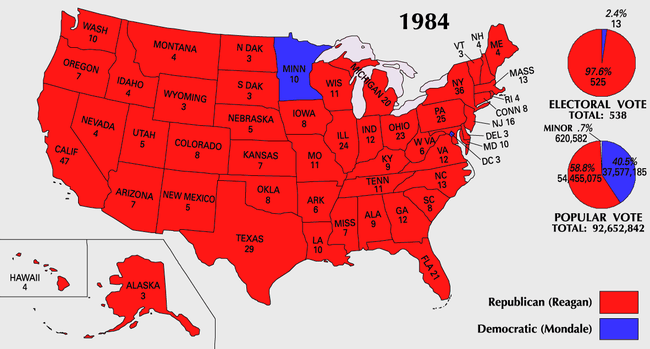
-
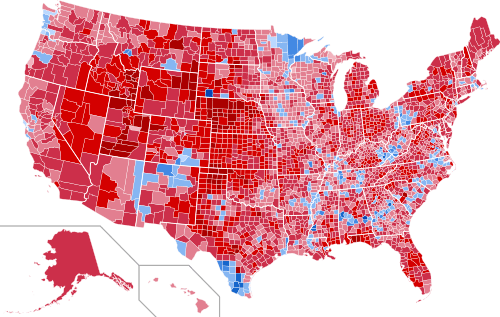
Results by county, shaded according to winning candidate's percentage of the vote
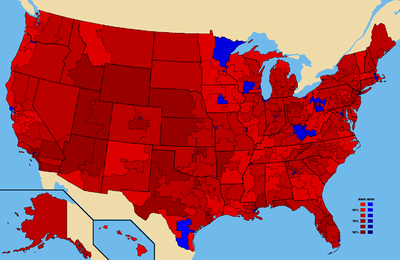
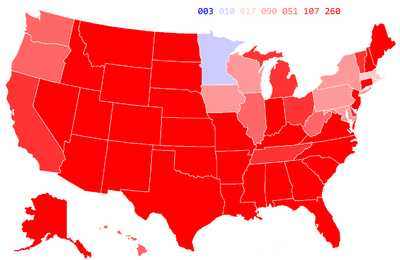
Reagan was re-elected in the November 6 election in an electoral and popular vote landslide, winning 49 states. He won a record 525 electoral votes total (of 538 possible), and received 58.8% of the popular vote; despite Ferraro's selection, 55% of women who voted did so for Reagan,[55] and his 54 to 61% of the Catholic vote was the highest for a Republican candidate in history.[60] Mondale's 13 electoral college votes (from his home state of Minnesota—which he won by 0.18%—and the District of Columbia) marked the lowest total of any major presidential candidate since Alf Landon's 1936 loss to Franklin D. Roosevelt. Mondale's defeat was also the worst for any Democratic Party candidate in American history in the Electoral College (and his 13 electoral votes the fewest any Democrat has won since Stephen A. Douglas claimed 12 in the 1860 election, when the Democratic vote was divided), though others, including Alton B. Parker, James M. Cox, John W. Davis, and George S. McGovern, did worse in the popular vote.
Psephologists attributed the Republican victory to "Reagan Democrats", millions of Democrats who voted for Reagan, as in 1980. They characterized such Reagan Democrats as southern whites and northern blue collar workers who voted for Reagan because they credited him with the economic recovery, saw Reagan as strong on national security issues, and perceived the Democrats as supporting the poor and minorities at the expense of the middle class. The Democratic National Committee commissioned a study after the election that came to these conclusions, but suppressed the report, afraid that it would offend its key voters.[60]
When Reagan was asked in December 1984 what he wanted for Christmas he joked, "Well, Minnesota would have been nice".[61] Reagan lost Minnesota in both this election and in 1980, making it the only state he failed to win in either election, and also making him the first two-term president not to carry Minnesota since Woodrow Wilson. This is the last election where the Republican candidate achieved any of the following: Win every state in the Northeastern and Pacific regions of the United States; win at least one county in every state; and win any of the following states: Hawaii, Massachusetts, New York, Oregon, Rhode Island, and Washington. This was also the last election in which the winning candidate won by a double-digit margin in the percentage of the popular vote, and the last election where the winning candidate won by an eight-digit margin in total popular votes (10 million or more). Finally, despite his narrow loss in Minnesota, Reagan still managed to win in five out of its eight congressional districts (by contrast, Nixon had only carried one Massachusetts district twelve years earlier) thus making Reagan the only U.S. presidential candidate in history to win the popular vote in a majority of congressional districts in every state.
Statistics
Source for the popular vote: Leip, David. "1984 Presidential Election Results". Dave Leip's Atlas of U.S. Presidential Elections. Retrieved August 7, 2005. Source for the electoral vote: "Electoral College Box Scores 1789–1996". National Archives and Records Administration. Retrieved August 7, 2005.
Results by state
| States won by Reagan/Bush |
| State/district won by Mondale/Ferraro |
| Ronald Reagan Republican |
Walter Mondale Democratic |
David Bergland Libertarian |
Margin | State Total | ||||||||||
|---|---|---|---|---|---|---|---|---|---|---|---|---|---|---|
| State | electoral votes |
# | % | electoral votes |
# | % | electoral votes |
# | % | electoral votes |
# | % | # | |
| Alabama | 9 | 872,849 | 60.54 | 9 | 551,899 | 38.28 | – | 9,504 | 0.66 | – | 320,950 | 22.26 | 1,441,713 | AL |
| Alaska | 3 | 138,377 | 66.65 | 3 | 62,007 | 29.87 | – | 6,378 | 3.07 | – | 76,370 | 36.79 | 207,605 | AK |
| Arizona | 7 | 681,416 | 66.42 | 7 | 333,854 | 32.54 | – | 10,585 | 1.03 | – | 347,562 | 33.88 | 1,025,897 | AZ |
| Arkansas | 6 | 534,774 | 60.47 | 6 | 338,646 | 38.29 | – | 2,221 | 0.25 | – | 196,128 | 22.18 | 884,406 | AR |
| California | 47 | 5,467,009 | 57.51 | 47 | 3,922,519 | 41.27 | – | 49,951 | 0.53 | – | 1,544,490 | 16.25 | 9,505,423 | CA |
| Colorado | 8 | 821,818 | 63.44 | 8 | 454,974 | 35.12 | – | 11,257 | 0.87 | – | 366,844 | 28.32 | 1,295,381 | CO |
| Connecticut | 8 | 890,877 | 60.73 | 8 | 569,597 | 38.83 | – | – | – | – | 321,280 | 21.90 | 1,466,900 | CT |
| Delaware | 3 | 152,190 | 59.78 | 3 | 101,656 | 39.93 | – | 268 | 0.11 | – | 50,534 | 19.85 | 254,572 | DE |
| D.C. | 3 | 29,009 | 13.73 | – | 180,408 | 85.38 | 3 | 279 | 0.13 | – | −151,399 | −71.66 | 211,288 | DC |
| Florida | 21 | 2,730,350 | 65.32 | 21 | 1,448,816 | 34.66 | – | 754 | 0.02 | – | 1,281,534 | 30.66 | 4,180,051 | FL |
| Georgia | 12 | 1,068,722 | 60.17 | 12 | 706,628 | 39.79 | – | 151 | 0.01 | – | 362,094 | 20.39 | 1,776,093 | GA |
| Hawaii | 4 | 185,050 | 55.10 | 4 | 147,154 | 43.82 | – | 2,167 | 0.65 | – | 37,896 | 11.28 | 335,846 | HI |
| Idaho | 4 | 297,523 | 72.36 | 4 | 108,510 | 26.39 | – | 2,823 | 0.69 | – | 189,013 | 45.97 | 411,144 | ID |
| Illinois | 24 | 2,707,103 | 56.17 | 24 | 2,086,499 | 43.30 | – | 10,086 | 0.21 | – | 620,604 | 12.88 | 4,819,088 | IL |
| Indiana | 12 | 1,377,230 | 61.67 | 12 | 841,481 | 37.68 | – | 6,741 | 0.30 | – | 535,749 | 23.99 | 2,233,069 | IN |
| Iowa | 8 | 703,088 | 53.27 | 8 | 605,620 | 45.89 | – | 1,844 | 0.14 | – | 97,468 | 7.39 | 1,319,805 | IA |
| Kansas | 7 | 677,296 | 66.27 | 7 | 333,149 | 32.60 | – | 3,329 | 0.33 | – | 344,147 | 33.67 | 1,021,991 | KS |
| Kentucky | 9 | 822,782 | 60.04 | 9 | 539,589 | 39.37 | – | – | – | – | 283,193 | 20.66 | 1,370,461 | KY |
| Louisiana | 10 | 1,037,299 | 60.77 | 10 | 651,586 | 38.18 | – | 1,876 | 0.11 | – | 385,713 | 22.60 | 1,706,822 | LA |
| Maine | 4 | 336,500 | 60.83 | 4 | 214,515 | 38.78 | – | – | – | – | 121,985 | 22.05 | 553,144 | ME |
| Maryland | 10 | 879,918 | 52.51 | 10 | 787,935 | 47.02 | – | 5,721 | 0.34 | – | 91,983 | 5.49 | 1,675,873 | MD |
| Massachusetts | 13 | 1,310,936 | 51.22 | 13 | 1,239,606 | 48.43 | – | – | – | – | 71,330 | 2.79 | 2,559,453 | MA |
| Michigan | 20 | 2,251,571 | 59.23 | 20 | 1,529,638 | 40.24 | – | 10,055 | 0.26 | – | 721,933 | 18.99 | 3,801,658 | MI |
| Minnesota | 10 | 1,032,603 | 49.54 | – | 1,036,364 | 49.72 | 10 | 2,996 | 0.14 | – | −3,761 | −0.18 | 2,084,449 | MN |
| Mississippi | 7 | 581,477 | 61.85 | 7 | 352,192 | 37.46 | – | 2,336 | 0.25 | – | 229,285 | 24.39 | 940,192 | MS |
| Missouri | 11 | 1,274,188 | 60.02 | 11 | 848,583 | 39.98 | – | – | – | – | 425,605 | 20.05 | 2,122,771 | MO |
| Montana | 4 | 232,450 | 60.47 | 4 | 146,742 | 38.18 | – | 5,185 | 1.35 | – | 85,708 | 22.30 | 384,377 | MT |
| Nebraska | 5 | 460,054 | 70.55 | 5 | 187,866 | 28.81 | – | 2,079 | 0.32 | – | 272,188 | 41.74 | 652,090 | NE |
| Nevada | 4 | 188,770 | 65.85 | 4 | 91,655 | 31.97 | – | 2,292 | 0.80 | – | 97,115 | 33.88 | 286,667 | NV |
| New Hampshire | 4 | 267,051 | 68.66 | 4 | 120,395 | 30.95 | – | 735 | 0.19 | – | 146,656 | 37.71 | 388,954 | NH |
| New Jersey | 16 | 1,933,630 | 60.09 | 16 | 1,261,323 | 39.20 | – | 6,416 | 0.20 | – | 672,307 | 20.89 | 3,217,862 | NJ |
| New Mexico | 5 | 307,101 | 59.70 | 5 | 201,769 | 39.23 | – | 4,459 | 0.87 | – | 105,332 | 20.48 | 514,370 | NM |
| New York | 36 | 3,664,763 | 53.84 | 36 | 3,119,609 | 45.83 | – | 11,949 | 0.18 | – | 545,154 | 8.01 | 6,806,810 | NY |
| North Carolina | 13 | 1,346,481 | 61.90 | 13 | 824,287 | 37.89 | – | 3,794 | 0.17 | – | 522,194 | 24.00 | 2,175,361 | NC |
| North Dakota | 3 | 200,336 | 64.84 | 3 | 104,429 | 33.80 | – | 703 | 0.23 | – | 95,907 | 31.04 | 308,971 | ND |
| Ohio | 23 | 2,678,560 | 58.90 | 23 | 1,825,440 | 40.14 | – | 5,886 | 0.13 | – | 853,120 | 18.76 | 4,547,619 | OH |
| Oklahoma | 8 | 861,530 | 68.61 | 8 | 385,080 | 30.67 | – | 9,066 | 0.72 | – | 476,450 | 37.94 | 1,255,676 | OK |
| Oregon | 7 | 685,700 | 55.91 | 7 | 536,479 | 43.74 | – | – | – | – | 149,221 | 12.17 | 1,226,527 | OR |
| Pennsylvania | 25 | 2,584,323 | 53.34 | 25 | 2,228,131 | 45.99 | – | 6,982 | 0.14 | – | 356,192 | 7.35 | 4,844,903 | PA |
| Rhode Island | 4 | 212,080 | 51.66 | 4 | 197,106 | 48.02 | – | 277 | 0.07 | – | 14,974 | 3.65 | 410,492 | RI |
| South Carolina | 8 | 615,539 | 63.55 | 8 | 344,470 | 35.57 | – | 4,360 | 0.45 | – | 271,069 | 27.99 | 968,540 | SC |
| South Dakota | 3 | 200,267 | 63.00 | 3 | 116,113 | 36.53 | – | – | – | – | 84,154 | 26.47 | 317,867 | SD |
| Tennessee | 11 | 990,212 | 57.84 | 11 | 711,714 | 41.57 | – | 3,072 | 0.18 | – | 278,498 | 16.27 | 1,711,993 | TN |
| Texas | 29 | 3,433,428 | 63.61 | 29 | 1,949,276 | 36.11 | – | – | – | – | 1,484,152 | 27.50 | 5,397,571 | TX |
| Utah | 5 | 469,105 | 74.50 | 5 | 155,369 | 24.68 | – | 2,447 | 0.39 | – | 313,736 | 49.83 | 629,656 | UT |
| Vermont | 3 | 135,865 | 57.92 | 3 | 95,730 | 40.81 | – | 1,002 | 0.43 | – | 40,135 | 17.11 | 234,561 | VT |
| Virginia | 12 | 1,337,078 | 62.29 | 12 | 796,250 | 37.09 | – | – | – | – | 540,828 | 25.19 | 2,146,635 | VA |
| Washington | 10 | 1,051,670 | 55.82 | 10 | 807,352 | 42.86 | – | 8,844 | 0.47 | – | 244,318 | 12.97 | 1,883,910 | WA |
| West Virginia | 6 | 405,483 | 55.11 | 6 | 328,125 | 44.60 | – | – | – | – | 77,358 | 10.51 | 735,742 | WV |
| Wisconsin | 11 | 1,198,800 | 54.19 | 11 | 995,847 | 45.02 | – | 4,884 | 0.22 | – | 202,953 | 9.18 | 2,212,016 | WI |
| Wyoming | 3 | 133,241 | 70.51 | 3 | 53,370 | 28.24 | – | 2,357 | 1.25 | – | 79,871 | 42.27 | 188,968 | WY |
| TOTALS: | 538 | 54,455,472 | 58.77 | 525 | 37,577,352 | 40.56 | 13 | 228,111 | 0.25 | – | 16,878,120 | 18.22 | 92,653,233 | US |
Close states
Margin of victory less than 5% (27 electoral votes) [63][64]
- Minnesota, 0.18%
- Massachusetts, 2.79%
- Rhode Island, 3.65%
Margin of victory more than 5%, but less than 10% (90 electoral votes) [63][64]
- Maryland, 5.49%
- Pennsylvania, 7.35%
- Iowa, 7.38%
- New York, 8.01%
- Wisconsin, 9.17%
Notable expressions and phrases
- Where's the beef?: A slogan used by Wendy's Restaurant to suggest that their competitors have smaller portions of meat in their sandwiches, but used in the election to suggest an opponent's position lacked substance.
- Morning in America: Slogan used by the Reagan campaign.
See also
- United States Senate elections, 1984
- United States House of Representatives elections, 1984
- History of the United States (1980–1991)
- Second inauguration of Ronald Reagan
References
- ↑ "Dave Leip's Atlas of U.S. Presidential Elections". uselectionatlas.org. Retrieved October 21, 2012.
- ↑ Raines, Howell (November 7, 1984). "Reagan Wins By a Landslide, Sweeping at Least 48 States; G.O.P. Gains Strength in House". The New York Times. Retrieved March 21, 2013.
- ↑ "Ourcampaigns.com". Ourcampaigns.com. Retrieved August 11, 2014.
- ↑ "1984 PRESIDENTIAL ANNOUNCEMENT SPEECH OF GEORGE McGOVERN". 4president.org. September 13, 1983. Retrieved August 11, 2014.
- ↑ Skipper, John C. The Iowa Caucuses: First Tests of Presidential Aspiration, 1972–2008, pg. 72–73
- ↑ Larry J. Sabato's Feeding Frenzy (July 21, 1998). "Jesse Jackson's 'Hymietown' Remark – 1984". Washington Post. Retrieved May 26, 2010.
- 1 2 Thomas, Evan; Allis, Sam; Beckwith, David (July 2, 1984). "Trying to Win the Peace". Time Magazine.
- ↑ Kurt Andersen, "A Wild Ride to the End", Time, May 28, 1984
- ↑ Ruth Marcus, "Parsing Tsunami Tuesday", Washington Post, January 16, 2008
- ↑ "Candidate – Jim Bates". Our Campaigns. Retrieved January 16, 2011.
- 1 2 3 4 5 6 7 8 9 10 11 12 13 "Democrats Choose Delegates". The New York Times. January 24, 1984. Retrieved August 11, 2014.
- ↑ "IA US President – D Caucuses Race – Jan 24, 1984". Our Campaigns. Retrieved January 16, 2011.
- 1 2 3 Lynn, Frank (January 15, 1984). "State Drawing Presidential Hopefuls". The New York Times. New York State. Retrieved August 11, 2014.
- ↑ "NY US President – D Primary Race – Apr 03, 1984". Our Campaigns. Retrieved January 16, 2011.
- 1 2 3 4 "US President – D Primaries – Feb 01, 1984". Our Campaigns. February 7, 2008. Retrieved March 7, 2008.
- 1 2 3 4 Raines, Howell (January 29, 1984). "Southern Primaries Could Spell Trouble For Glenn". The New York Times. Retrieved August 11, 2014.
- 1 2 3 4 Raines, Howell (October 20, 1983). "Democrats Pursue Southern Support". The New York Times. Retrieved August 11, 2014.
- 1 2 Raines, Howell (December 12, 1983). "MONDALE HAD GOOD '83 – NOW THE REAL TEST BEGINS". The New York Times. Retrieved August 11, 2014.
- ↑ Boyd, Gerald M. (December 11, 1983). "Alabama Blacks' Group Decides To Back Mondale-Jackson Ticket". The New York Times. Retrieved August 11, 2014.
- 1 2 3 Smith, Hedrick (February 25, 1984). "Experts Say The South Looks Blead For Glenn". The New York Times. Retrieved August 11, 2014.
- 1 2 HOWELL RAINES, Special to the New York Times (November 4, 1983). "A Provocative Candidate". The New York Times. Retrieved August 11, 2014.
- 1 2 Gailey, Phil (December 5, 1983). "Political Potholes Ahead For Traveling Democrats". The New York Times. Chicago (Ill). Retrieved August 11, 2014.
- ↑ HOWELL RAINES, Special to the New York Times (February 26, 1984). "8 DEMOCRATS GIRD FOR KEY PRIMARY IN NEW HAMPSHIRE". The New York Times. New Hampshire. Retrieved August 11, 2014.
- ↑ "Ourcampaigns.com". Ourcampaigns.com. Retrieved August 11, 2014.
- ↑ Raines, Howell (October 19, 1983). "Politics – Hart'S Tactics Askew'S Train And Film Anxieties". The New York Times. Retrieved August 11, 2014.
- 1 2 Plotz, David (August 20, 1999) Warren Beatty, Slate.com
- ↑ Smothers, Ronald (November 1, 1983). "Democratic Candidates Welcome Jackson Bid For Nomination". The New York Times. Retrieved August 11, 2014.
- ↑ "Candidate – Orval E. Faubus". Our Campaigns. Retrieved January 16, 2011.
- 1 2 3 Smothers, Ronald (November 4, 1983). "Jackson Declares Formal Candidacy". The New York Times. Retrieved August 11, 2014.
- ↑ Smothers, Ronald (December 28, 1983). "Jackson Wins Attention But Strength Is Unclear". The New York Times. Retrieved August 11, 2014.
- 1 2 Ronald Smothers (March 12, 1984). "Alabama Black Leaders Are Urging Pragmatism In Supporting Mondale". The New York Times. Retrieved August 11, 2014.
- 1 2 Smothers, Ronald (January 15, 1984). "Jackson Attracts Crowds, But Planning Is Erratic". The New York Times. Retrieved August 11, 2014.
- ↑ "Candidate – Marion S. Barry, Jr". Our Campaigns. Retrieved January 16, 2011.
- ↑ Raines, Howell (December 2, 1983). "Jackson Gets Support, Apparently Without Poll Of The Group". The New York Times. Retrieved August 11, 2014.
- 1 2 3 Boyd, Gerald M. (February 14, 1984). "Black Churches A Mainspring Of Jackson'S Efforts". The New York Times. Retrieved August 11, 2014.
- ↑ "Barry Commoner Vows To Back Jesse Jackson". Nytimes.com. August 30, 1983. Retrieved January 18, 2015.
- ↑ "Our Campaigns – GA US President – D Primary Race – Mar 13, 1984". Ourcampaigns.com. Retrieved January 18, 2015.
- ↑ "MA US President – D Primary Race – Mar 13, 1984". Our Campaigns. Retrieved January 16, 2011.
- ↑ "GLENN SEEKING TO TURN A HERO'S IMAGE INTO VOTES". Nytimes.com. June 15, 1983. Retrieved January 18, 2015.
- ↑ "Our Campaigns – AL US President – D Primary Race – Mar 13, 1984". Ourcampaigns.com. Retrieved January 18, 2015.
- ↑ "Our Campaigns – FL US President – D Primary Race – Mar 13, 1984". Ourcampaigns.com. Retrieved January 18, 2015.
- ↑ "ASKEW TELLS MOBILE HE 'FEELS GOOD' ABOUT RACE". Nytimes.com. February 7, 1984. Retrieved January 18, 2015.
- ↑ Howell Raines (July 20, 1984). "Party Nominates Rep. Ferraro; Mondale, in Acceptance, Vows Fair Policies and Deficit Cut". New York Times. p. A1.
- 1 2 3 4 Church, George L.; Magnuson, Ed (July 23, 1984). "Geraldine Ferraro: A Break with Tradition". Time. Retrieved March 26, 2011.
- ↑ Blumenthal, Ralph (September 8, 2008). "When the Press Vetted Geraldine Ferraro". The New York Times. Retrieved March 26, 2011.
- ↑ Buckley, Cara (March 28, 2011). "Of Ferraro's Roles in Many Arenas, a Favorite: Gerry From Queens". The New York Times. pp. A18. Retrieved March 30, 2011.
- ↑ New York Times, June 11, 1983
- ↑ New York Times, November 9, 1983
- ↑ New York Times, April 20, 1984
- ↑ New York Times, April 27, 1984
- ↑ New York Times, May 4, 1984
- ↑ New York Times, August 28, 1984
- ↑ "Former Congressman John Anderson Runs for President Again in 1984". Archives.nbclearn.com. Retrieved January 18, 2015.
- ↑ https://news.google.com/newspapers?id=dU4tAAAAIBAJ&sjid=VM8FAAAAIBAJ&pg=3911,4640110&dq=gene-burns+radio&hl=en
- 1 2 Martin, Douglas (March 27, 2011). "Geraldine A. Ferraro, First Woman on Major Party Ticket, Dies at 75". The New York Times. pp. A1. Retrieved March 26, 2011.
- ↑ "Born In The U.S.A. by Bruce Springsteen Songfacts". Songfacts.com. Retrieved January 18, 2015.
- ↑ "1984 Presidential Candidate Debate: President Reagan and Walter Mondale – 10/7/84". Debates. October 7, 1984. Retrieved January 15, 2011.
- ↑ Reagan, Ronald; Mondale, Walter (April 27, 2009). 1984 Presidential Candidate Debate: President Reagan and Walter Mondale – 10/21/84. The Ronald Reagan Presidential Foundation. Event occurs at 32:55.
- ↑ Mondale, Walter. "1984: There You Go Again... Again / Debating Our Destiny Transcript". PBS Newshour (Interview). Interview with Lehrer, Jim. Archived from the original on 2000-12-12. Retrieved February 29, 2012.
- 1 2 Prendergast, William B. (1999). The Catholic vote in American politics. Washington DC: Georgetown University Press. pp. 186, 191–193. ISBN 0-87840-724-3.
- ↑ "Minnesota heads Reagan's wish list". The Tuscaloosa News. Tuscaloosa, Alabama. Associated Press. December 4, 1984. p. 27. Retrieved July 18, 2012.
- ↑ "1984 Presidential General Election Data – National". Retrieved March 17, 2013.
- 1 2 "POPULAR VOTE AND ELECTORAL COLLEGE VOTE BY STATE" (TXT). Psephos.adam-carr.net. Retrieved 18 January 2015.
- 1 2 "Dave Leip's Atlas of U.S. Presidential Elections – County Data". Uselectionatlas.org. Retrieved January 16, 2011.
Further reading
- Jonathan Moore, ed. (1986). Campaign for President: The Managers Look at '84. Dover: Auburn House. ISBN 0-86569-132-0.
- Ladd, Everett Carll (1985). "On Mandates, Realignments, and the 1984 Presidential Election". Political Science Quarterly. 100 (1): 1–24. JSTOR 2150858.
- Leuchtenburg, William E. (1986). The 1984 Election in Historical Perspective. Waco: Baylor University Press. ISBN 0-918954-45-2.
- Morris, Lorenzo (1990). The Social and Political Implications of the 1984 Jesse Jackson Presidential Campaign. New York: Praeger. ISBN 0-275-92785-7.
- Sandoz, E.; Crabb, C. V., Jr., eds. (1985). Election 84: Landslide Without a Mandate?. New York: New American Library. ISBN 0-451-62424-6.
- Stempel, Guido H., III; John W. Windhauser (1991). The Media in the 1984 and 1988 Presidential Campaigns. New York: Greenwood Press. ISBN 0-313-26527-5.
External links
- The Election Wall's 1984 Election Video Page
- 1984 popular vote by counties
- 1984 popular vote by states
- 1984 popular vote by states (with bar graphs)
- Campaign commercials from the 1984 election
- Democratic primaries at the Wayback Machine (archived October 26, 2009)
- "How close was the 1984 election?". Archived from the original on August 25, 2012. Retrieved April 3, 2010. Michael Sheppard, Massachusetts Institute of Technology.
- Election of 1984 in Counting the Votes
